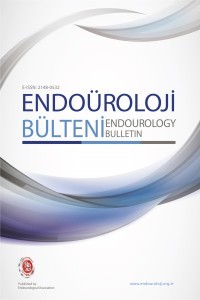Radikal prostatektomi yapılmış intermediate risk prostat kanseri hastalarında postoperatif sonuçların karşılaştırılması
Penil fraktür, Erektil Disfonksiyon, Penil Hematom
Comparison of postoperative results in intermediate risk prostate cancer patients with radical prostatectomy
penile fracture, Erectile dysfunction, penile hematoma,
___
- 1. Siegel R, Ma J, Zou Z, et al. Cancerstatistics. CA Cancer J Clin 2014; 64:9–29.
- 2. National Comprehensive Cancer Network NCCN clinical practice guidelines in oncology: prostate cancer 2019.
- 3. Grossfeld GD, Latini DM, Lubeck DP, Mehta SS, Carroll PR. Predicting recurrence after radical prostatectomy for patients with high risk prostate cancer. J Urol. 2003; 169:157-63.
- 4. D’Amico AV. Biochemical outcome after radical prostatectomy, external beam radiation therapy, or interstitial radiation therapy for clinically localized prostate cancer. JAMA. 1998; 280:969.
- 5. Jung J-W, Lee JK, Hong SK, Byun S-S, Lee SE. Stratifcation of patients with intermediate-risk prostate cancer. BJU Int. 2015; 115:907–12.
- 6. Sanda MG, Cadeddu JA, Kirkby E, Chen RC, Crispino T, Fontanarosa J, et al. Clinically localized prostate cancer: AUA/ASTRO/ SUO guideline. Part I: risk stratifcation, shared decision making, and care options. J Urol. 2018; 199:683-90.
- 7. Siegel R, Naishadham D, Jemal A. Cancer statistics, 2012. CA Cancer J Clin 2012; 62:10–29.
- 8. Zumsteg ZS, Chen Z, Howard LE, et al. Number of unfavorable intermediate-risk factors predicts pathologic upstaging and prostate cancer-specific mortality following radical prostatectomy: results from the SEARCH database. Prostate 2017; 77:154–63.
- 9. Mottet N, van den Bergh RCN, Briers E, et al. EAU – ESTRO – ESUR – SIOG guidelines on prostate cancer. 2019.
- 10. Mohler JL, Antonarakis ES, Armstrong AJ, et al. Prostate cancer, version 2.2019, NCCN clinical practice guidelines in oncology. J Natl Compr Canc Netw 2019; 17:479–505.
- 11. Hamdy FC, Donovan JL, Lane JA, et al. 10-Year outcomes after monitoring, surgery, or radiotherapy for localized prostate cancer. N Engl J Med 2016; 375:1415–24.
- 12. Klotz L, Vesprini D, Sethukavalan P, et al. Long-term follow-up of a large active surveillance cohort of patients with prostate cancer. J Clin Oncol 2015; 33:272–7.
- 13. Stewart SB, Boorjian SA. Radical prostatectomy in high-risk and locally advanced prostate cancer: Mayo Clinic perspective. Urol Oncol 2015; 33:235-244
- 14. Sanda Martin G, Cadeddu Jeffrey A, Erin Kirkby, et al. Clinically localized prostate cancer: AUA/ASTRO/SUO guideline. Part I: risk stratification, shared decision making, and care options. J Urol 2018; 199:683–90.
- 15. Bill-Axelson A, Holmberg L, Garmo H, et al. Radical prostatectomy or watchful waiting in prostate cancer—29-year follow-up. N Engl J Med 2018; 379:2319-29.
- 16. Wilt TJ, Jones KM, Barry MJ, et al. Follow-up of prostatectomy versus observation for early prostate cancer. N Engl J Med 2017; 377:132-42.
- 17. Wallis CJD, Saskin R, Choo R, et al. Surgery versus radiotherapy for clinically-localized prostate cancer: a systematic review and metaanalysis. Eur Urol 2016; 70:21–30.
- 18. Hoffman KE, Voong KR, Levy LB, et al. Randomized trial of hypo- fractionated, dose-escalated, intensity-modulated radiation therapy (IMRT) versus conventionally fractionated IMRT for localized prostate cancer. J Clin Oncol 2018; 36:2943-9.
- 19. Chua S, Qureshi MM, Boyd G, Gignac GA, Hirsch AE. Outcomes for Young Men With Localized Intermediate-Risk Prostate Cancer: An Analysis of the NCDB. Clin Genitourin Cancer. 2020 Feb 22. pii: S1558-7673(20) 30036-7.
- Yayın Aralığı: Yılda 3 Sayı
- Başlangıç: 2020
- Yayıncı: ENDOÜROLOJİ DERNEĞİ
Laparoskopik nefrektomide spesmen çıkarma yönteminin hasta memnuniyetine etkisi
Serkan DOĞAN, Bülent ÇELİK, Mehmet YILMAZ
Endoskopik Taş Tedavisinde Gelecekte Bizleri Ne Bekliyor?
Fatih SANDIKÇI, Burhan BAYLAN, Abdurrahim İMAMOĞLU
Genç populasyonda mesane tümörlerinin klinik ve patolojik özellikleri
Sercan YILMAZ, Ali YILDIZ, Serdar YALÇIN, Can SİCİMLİ, Ali Fuat ÇİÇEK, Bahadır TOPUZ, Selahattin BEDİR
Thulium Lazer ile Prostat Enükleasyonu(ThuLEP) deneyimleri
Eymen GAZEL, Mehmet YILMAZ, Halil Çağrı AYBAL, Engin KAYA, Serdar YALÇIN, Sercan YILMAZ, Onur AÇIKGÖZ, Lütfi TUNÇ
Bahadır TOPUZ, Sercan YILMAZ, Serdar YALÇIN, Sanan ASGARLI, Engin KAYA, Murat ZOR, Mesut GÜRDAL, Selahattin BEDİR
Retzius Koruyucu Robot Yardımlı Laparoskopik Radikal Prostatektomi
Serkan ALTINOVA, Çağrı GÜNERİ, Muhammet Fuat ÖZCAN
Endoskopik Kombine İntrarenal Cerrahi
İlker ŞEÇKİNER, Ali Erdem YILMAZ, Mehmet ÖZTÜRK
Laparoskopik üreterolitotomi; siz hangi yolu tercih ediyorsunuz?
Arif AYDIN, Gökhan ECER, Muzaffer KILINÇ, Mehmet BALASAR, Nurullah ALTINKAYA, Hakan TAŞKAPU, Mehmet Giray SÖNMEZ
